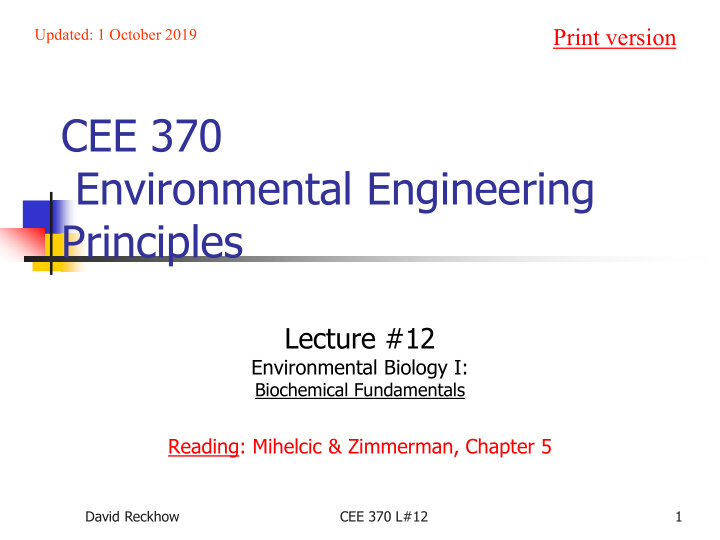



Print version Updated: 1 October 2019 CEE 370 Environmental Engineering Principles Lecture #12 Environmental Biology I: Biochemical Fundamentals Reading: Mihelcic & Zimmerman, Chapter 5 David Reckhow CEE 370 L#12 1
Why study microorganisms Biodegradation! They are the engines of our wastewater treatment system They are often used to purify drinking water They account for natural attenuation of pollutants They may interfere in treatment systems Indicators of environmental degradation Some are disease causing agents Future biotechnology Can we harness and engineer their biochemical engines? Molecular biology Genomics Proteomics 2 CEE 370 L#12 David Reckhow
What is the next lowest category below “Phylum” A. Kingdom B. Discipline C. Domain D. Class E. Order 3 CEE 370 L#12 David Reckhow
phylogeny Domains Archae Procaryotes Bacteria Eucaryotes – nucleus, organelles Kingdoms of Eucaryotes Protists, Fungi, Plants, Animals Other: KPCOFGS 4 CEE 370 L#12 David Reckhow
Environmental Microbiology Types of Microorganisms Bacteria Viruses Protozoa Rotifers Fungi Metabolism Microbial Disease Microbial Growth 5 CEE 370 L#12 David Reckhow
Biochemical Molecules Carbohydrates: polysaccharides & sugars Sources of energy, structural components, markers for identification & communication Nucleic Acids Transmit information across generations – the blueprint, code for protein synthesis Proteins & amino acids Site of reactions, transport, storage, structure, defense Lipids Storage of energy, membrane functions 6 CEE 370 L#12 David Reckhow
Carbohydrates Polyhydroxy aldehydes and ketones Empirical formula: CH 2 O Monomer: sugars Linear chain and ring forms example: glucose 7 CEE 370 L#12 David Reckhow
Types of sugars Position of carbonyl Terminal: aldehyde – an aldose Mid-chain: ketone – a ketose Number of carbons Three – triose Five – pentose Six - hexose 8 CEE 370 L#12 David Reckhow
Polymeric carbohydrates Disaccharides Example: sucrose D-glucose + D-fructose Glycosidic bonds Polysaccharides Example: Starch Amylose unit Linear array of Glucose units 9 CEE 370 L#12 David Reckhow
Large polysaccharides Glycogen Long-term storage in animals & fungi Core protein surrounded by glucose chains 10 CEE 370 L#12 David Reckhow
Lipids I Hydrophobic – not very soluble in water Fats Glycerol + fatty acids bound by ester linkages 11 CEE 370 L#12 David Reckhow
Lipids II Phospholipids Major components of cell membranes Composed of a glycerol, 2 fatty acids and a phosphate group 12 CEE 370 L#12 David Reckhow
Steroids 4 fused rings 13 CEE 370 L#12 David Reckhow
Others Very important and will be discussed in lecture on genetics (#10) Proteins, amino acids Bases, Nucleic acids, DNA, RNA 14 CEE 370 L#12 David Reckhow
To next lecture 15 CEE 370 L#12 David Reckhow
Recommend
More recommend